We currently have two varieties of Forget-Me-Nots blooming on the farm. Although they are not of the same genus, they are related, as both belong to the Boraginaceae (Borage) family. One is native to California, the other was introduced, escaped cultivation, and has now naturalized in many parts of the State.
Cynoglossum grande
Our native Forget-Me-Not is Cynoglossum grande, also known as Pacific Hound’s Tongue. This perennial herb is native to western North America, from British Columbia to California.
Pacific Hound’s Tongue is usually found in woodland and chaparral, favoring at least partial shade. This species emerges in late winter with bronze leaves, appearing somewhat tongue-like, gradually turning green as they mature.
The leaves are somewhat lance to heart-shaped, smooth above, and hairy below, clustering at the base of the plant.
The flowers are usually carried on a single hairless stem held above the leaves, between February and April, and consist of five petals, lavender to blue in color, with five white heart-shaped appendages in the center.

Emerging flower stalk of Pacific Hound's Tongue. Note the hairy under-surface of the adjacent leaves.
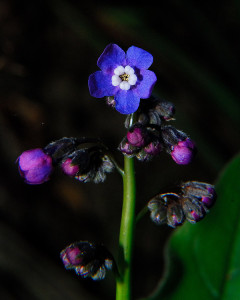
Pacific Hound's Tongue flowers have five petals, and five white appendages in the center of the flower
At least here on the farm, this plant appears to be relatively uncommon. Where it does occur, it seems to mostly favor dry shade, on steep southeast to southwest facing slopes, growing as an understory plant beneath oak and fir. The first specimen we noted however was found growing along the edge of our roadway.
Pacific Hound’s Tongue was used by Native Americans, including the Concow who would grate the roots and apply it as a burn dressing, and the Pomo who would use the grated roots as a treatment for stomachaches. [1]
We would love to see more of this somewhat elusive plant on the property. They are apparently difficult to transplant due to their deep and extensive taproots, and not always readily available at native plant nurseries. Hopefully by leaving the areas undisturbed where this plant seems to preferentially grow, it will slowly fill in on its own.
[1] Daniel E. Moerman’s Native American Ethnobotanical Database
Myosotis latifolia
The second species of Forget-Me-Not growing here, is actually native to northwestern Africa. It is an introduced species to the west coast of North America. Myosotis latifolia is also known as the Broadleaf Forget-Me-Not, and is found throughout California, especially in damp woodland.
It is fair to say that locally, this plant is quite invasive, clearly crowding out other native plants where it gains a strong foothold. In early spring, a profusion of blue flowers explodes across the base of our slopes, and along the edges of our roads and driveway.
The California Invasive Plant Council (Cal-IPC) assessed this species in 2006 and determined the statewide impact of this escaped cultivar is ‘limited’. Locally however, including here on the farm, this plant runs rampant at this time of year. Despite the Cal-IPC designation, the Santa Cruz County Department of Public Works lists Myosotis latifolia as a plant to avoid planting in creek-side gardens within the county.
Like the Pacific Hound’s Tongue, the flowers of Myosotis latifolia consist of five lavender to blue petals, but with an inner circle of yellow or white, and white ‘teeth’ along the petal edges. Myosotis latifolia produces dense flower clusters at the terminal end of the stem, and leaves are present along the entire length.
Myosotis latifolia seems to be quite heat and drought tolerant, and can be found here growing both in partial shade, and full sun. It forms a dense ground cover, and even manages to squeeze itself in between the dense thickets of Miner’s Lettuce, where little else succeeds in early spring. Clearly part of the reason for its success here is that deer and gophers simply leave it alone.
Myosotis latifolia is becoming increasingly common along trails around the Monterey Bay, spreading rapidly by seed, and has been observed to spread especially aggressively after fire, or soil disturbance. It will be interesting to see if its invasive status changes with the Cal-IPC in the near future.
Here on the farm, without supplemental summer water, Myosotis latifolia tends to die back in mid-summer. Although not as aggressively invasive as our French Broom, these Forget-Me-Nots do seem to be increasing here on the property, and are on our list of invasive plants in need of control here, once the more aggressive French Broom, and Vinca minor, are under control.
Silently, one by one, in the infinite meadows of Heaven,
Blossom the lovely stars, the forget-me-nots of the angels.
~Henry Wadsworth Longfellow


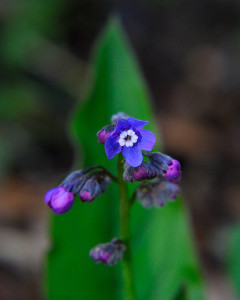
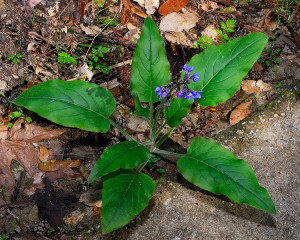
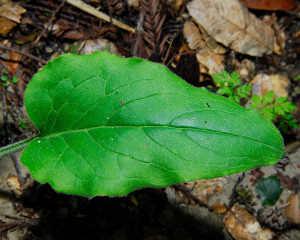
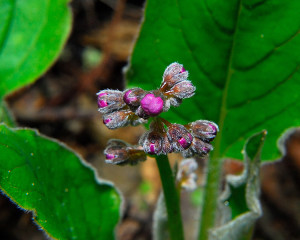
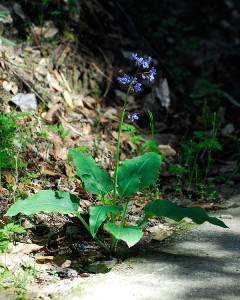
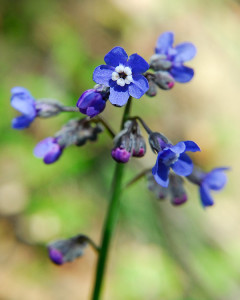


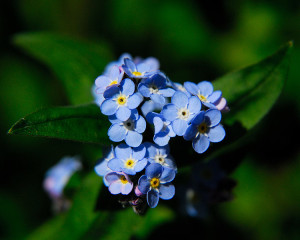










Oh, I’m so glad you’re describing each species. I was hiking just yesterday and wasn’t sure which Forget-me-not I was looking at. Hoping I can source some Cynoglossum grande for a new garden under an oak!
I haven’t seen many Bay Area nurseries with it listed, let alone available. However, Yerba Buena Nursery in Woodside apparently does have 1 gallon plants for $15:
http://www.yerbabuenanursery.com/Avail.php
Scroll down to perennials.
I have never seen this Longfellow’s quote but a huge lover of this simple/complex plant, thank you. I’m blessed to enjoy them both here and at my cottage. Forget-Me-Not (Myosotis scorpioides), often called Scorpion Weed because of coiled flower stalk, rules along rivers and streams. 7 species are found here in Michigan … I love them for many ‘of the angels’ reasons’ … but who could not! A simple vase of these beauties is ‘as good as it gets’!
Forget-me-nots are small plants that pack a lot of punch. Those blues really are unforgettable. I appreciate your distinguishing the native and invasive species.
.-= Jean´s last blog ..Gardens Worth Visiting: Sissinghurst =-.
What an amazing blue forget me nots are, you can forgive them (almost) anything.
.-= Deborah at Kilbourne Grove´s last blog ..Bloomin Canada =-.
Great info about this lovely blue flower. I have some Myosotis in my garden. i love it but it can get a bit bit of control.
.-= melanie´s last blog ..Perennials Take a Holiday Underground Every Winter =-.
What beautiful colors! Especially on the first picture.
.-= Tatyana´s last blog ..Friday Fluffs =-.
Reading your posts is always such a joy! They are always filled with beauty and much scientific knowledge. I love your last shot of Cynoglossum grande! ;>)
.-= Carol´s last blog ..Winter Melts Away! A Garden Walkabout! =-.
I’ve been seeing the houndstooth lately hiking. I haven’t noticed the invasive species blooming yet this year. I know here in Oakland’s Redwood Park volunteers pull the invasive forget-me-nots. Supposedly this has allowes many natives to thrive just from the extra room/sun.
.-= Brad B´s last blog ..Garden Bloggers’ Bloom Day – March =-.
I really liked the blooms of Myosotis latifolia. Forget-me-nots is considered a wild flower here and it is not common in plant nurseries due to its small flowers but i just love its color and masses of its blooms.
.-= muhammad khabbab @ Garden Geek´s last blog ..Blooming Friday =-.
Oh they are gorgeous I love them especially the Hound’s tooth, what simple, elegant, dainty flowers! Do they smell? Any forget-me-not I have seen here [Ireland] is extremely tiny and close to the ground, almost hiding.
.-= Carrie´s last blog ..All’s well that ends well.. =-.
oh my little avatar looks very worried indeed – fear not I am ok! xx
.-= Carrie´s last blog ..All’s well that ends well.. =-.
I didn’t realise that forget-me-nots were part of the borage family, but knowing that helps me understand just how well the invader would spread! The native Pacific Hound’s Tongue is the most beautiful blue. If I had those in my garden I would gaze at them for ages, just admiring their colour. But then again, I fell for the blue of borage once and spent the next two years pulling it out from everywhere!
.-= Heidi´s last blog ..Blotanical…ing =-.
I’m a huge fan of the Western variety. Somehow I didn’t realize that the one that I think of as “Eastern”
is actually an introduced species. Interesting!
Thanks for this interesting post. I didn’t realize that this flower, too, is invasive. We have plenty of it in our garden, and the blue flowers are gorgeous as a backdrop to red roses. If they spread too much, I just dig up some of it and put it on the compost. Barbara
.-= Barbara´s last blog ..Finally Spring Part I: Progress in the kitchen garden =-.
I love small and delicate looking flowers of both types. It is interesting to see the contrast between the small flowers and the large leaves.
.-= Noelle/azplantlady´s last blog ..Our Mysterious, Malfuntioning Hose…. =-.
I think the problem with the invasive forget-me-not is that the seeds are so sticky. They stick to my pants, and probably stick to any animal that happens by. Maybe mowing would help? I do agree they’re quite aggressive.
WOW! Now this little “weed” is awesome! The 1st and 6th photos are honestly crazy!! They grab the eye and hold it like nothing else! After seeing the bloom, then the plant itself, it’s fantastic to see how such a little blue bloom can turn heads if one looks closely! Then the 4th from the last photo really stopped me short as well. You’ve really captured these two types well, both in description and in photo. Very well done!!!
.-= kimberly´s last blog ..Just A Few Blooms =-.
I love forget me nots, both genera! The houndstongue aren’t invasive here at all; they reseed a bit for a couple of years but then dwindle away, and they also flower much, much later than do Myosotis for me, which is why I like them. My father died of Alzheimer’s, so Myosotis is all over my garden, for obvious reasons. Your photos are wonderful.
.-= jodi (bloomingwriter)´s last blog ..Spotlight Saturday: Have you visited This blogger? Introducing Cindee =-.
Lovely, have loved these ever since I was a little kid.
I can not grow forget me nots here in Georgia. I’m going to have to look into why as they are such lovely woodland flowers.
.-= Karyl´s last blog ..Native Trees and Shrubs in My Garden =-.